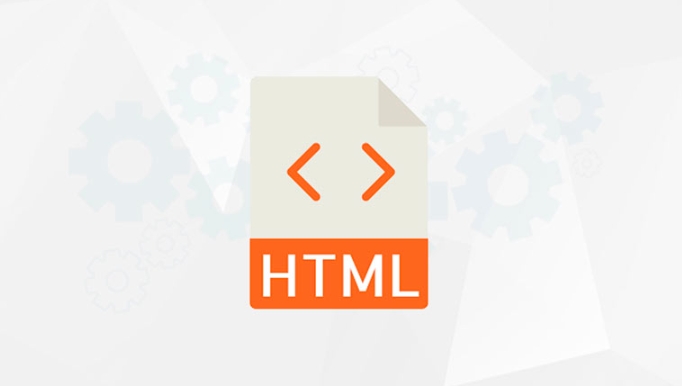 Web Front-end
Web Front-end
 HTML Tutorial
HTML Tutorial
 Why is it important to use the for in html attributes to connect a to an input?
Why is it important to use the for in html attributes to connect a to an input?
Why is it important to use the for in html attributes to connect a to an input?
Jun 25, 2025 pm 05:19 PMUsing the for attribute to connect a

When you're building a form in HTML, connecting a <label></label> to an <input> using the for attribute (or the id on the input) is important for both usability and accessibility. It might seem like a small detail, but it makes a big difference in how users interact with your site—especially those who rely on assistive technologies.
 to an input?" />
to an input?" />Improves Accessibility for Screen Readers
One of the main reasons to use the for attribute is to help screen readers understand which label belongs to which input field. When a <label></label> is properly connected to an <input>, screen readers will read out the label when the input is focused. This helps users with visual impairments know exactly what information is expected in each field.
 to an input?" />
to an input?" />- For example, if you have a text input for an email address and a label that says “Email,” connecting them means a screen reader user will hear “Email, edit text” when they tab into the input.
- Without this connection, the screen reader may not announce anything helpful, leaving the user confused.
To do this correctly:
- Give your
<input>anid. - Set the
forattribute on the<label></label>to match thatid.
This pairing ensures your form is more usable for people who navigate using screen readers or other assistive tools.
 to an input?" />
to an input?" />Enhances Click Target Area
Another benefit of linking labels and inputs with the for attribute is that it increases the clickable area for the input. When you click or tap on a label that's associated with an input (like a checkbox or radio button), the browser automatically focuses or toggles that input.
- This is especially useful on mobile devices where precision taps can be tricky.
- Even for text fields, clicking the label moves focus to the input, making it easier for users to start typing.
If the for attribute isn’t used (or the id doesn’t match), this behavior won't work consistently across browsers, leading to a less intuitive experience.
Helps Maintain Semantic Structure
HTML is designed to be semantic, meaning each tag has a specific purpose and relationship with others. Using <label></label> with the for attribute maintains that structure by clearly defining the relationship between labels and their inputs.
- Browsers, search engines, and assistive tools all rely on this structure to interpret and present content accurately.
- It also makes your code cleaner and more understandable for other developers who may work on the same project later.
For example, when dealing with complex forms that have many inputs, having clear label associations makes debugging and styling much easier down the line.
Connecting labels to inputs using the for attribute is a small but powerful practice. It supports accessibility, improves interaction, and keeps your HTML structured properly. While it’s easy to overlook, skipping this step can lead to real usability issues for some users.
The above is the detailed content of Why is it important to use the for in html attributes to connect a to an input?. For more information, please follow other related articles on the PHP Chinese website!

Hot AI Tools

Undress AI Tool
Undress images for free

Undresser.AI Undress
AI-powered app for creating realistic nude photos

AI Clothes Remover
Online AI tool for removing clothes from photos.

Clothoff.io
AI clothes remover

Video Face Swap
Swap faces in any video effortlessly with our completely free AI face swap tool!

Hot Article

Hot Tools

Notepad++7.3.1
Easy-to-use and free code editor

SublimeText3 Chinese version
Chinese version, very easy to use

Zend Studio 13.0.1
Powerful PHP integrated development environment

Dreamweaver CS6
Visual web development tools

SublimeText3 Mac version
God-level code editing software (SublimeText3)
 The `` vs. `` in HTML
Jul 19, 2025 am 12:41 AM
The `` vs. `` in HTML
Jul 19, 2025 am 12:41 AM
It is a block-level element, used to divide large block content areas; it is an inline element, suitable for wrapping small segments of text or content fragments. The specific differences are as follows: 1. Exclusively occupy a row, width and height, inner and outer margins can be set, which are often used in layout structures such as headers, sidebars, etc.; 2. Do not wrap lines, only occupy the content width, and are used for local style control such as discoloration, bolding, etc.; 3. In terms of usage scenarios, it is suitable for the layout and structure organization of the overall area, and is used for small-scale style adjustments that do not affect the overall layout; 4. When nesting, it can contain any elements, and block-level elements should not be nested inside.
 Essential HTML Tags for Beginners
Jul 27, 2025 am 03:45 AM
Essential HTML Tags for Beginners
Jul 27, 2025 am 03:45 AM
To get started with HTML quickly, you only need to master a few basic tags to build a web skeleton. 1. The page structure is essential, and, which is the root element, contains meta information, and is the content display area. 2. Use the title. The higher the level, the smaller the number. Use tags to segment the text to avoid skipping the level. 3. The link uses tags and matches the href attributes, and the image uses tags and contains src and alt attributes. 4. The list is divided into unordered lists and ordered lists. Each entry is represented and must be nested in the list. 5. Beginners don’t have to force memorize all tags. It is more efficient to write and check them while you are writing. Master the structure, text, links, pictures and lists to create basic web pages.
 Shadow DOM Concepts and HTML Integration
Jul 24, 2025 am 01:39 AM
Shadow DOM Concepts and HTML Integration
Jul 24, 2025 am 01:39 AM
ShadowDOM is a technology used in web component technology to create isolated DOM subtrees. 1. It allows the mount of an independent DOM structure on ordinary HTML elements, with its own styles and behaviors, and does not affect the main document; 2. Created through JavaScript, such as using the attachShadow method and setting the mode to open; 3. When used in combination with HTML, it has three major features: clear structure, style isolation and content projection (slot); 4. Notes include complex debugging, style scope control, performance overhead and framework compatibility issues. In short, ShadowDOM provides native encapsulation capabilities for building reusable and non-polluting UI components.
 Why is my image not showing up in HTML?
Jul 28, 2025 am 02:08 AM
Why is my image not showing up in HTML?
Jul 28, 2025 am 02:08 AM
Image not displayed is usually caused by a wrong file path, incorrect file name or extension, HTML syntax issues, or browser cache. 1. Make sure that the src path is consistent with the actual location of the file and use the correct relative path; 2. Check whether the file name case and extension match exactly, and verify whether the image can be loaded by directly entering the URL; 3. Check whether the img tag syntax is correct, ensure that there are no redundant characters and the alt attribute value is appropriate; 4. Try to force refresh the page, clear the cache, or use incognito mode to eliminate cache interference. Troubleshooting in this order can solve most HTML image display problems.
 HTML `style` Tag: Inline vs. Internal CSS
Jul 26, 2025 am 07:23 AM
HTML `style` Tag: Inline vs. Internal CSS
Jul 26, 2025 am 07:23 AM
The style placement method needs to be selected according to the scene. 1. Inline is suitable for temporary modification of single elements or dynamic JS control, such as the button color changes with operation; 2. Internal CSS is suitable for projects with few pages and simple structure, which is convenient for centralized management of styles, such as basic style settings of login pages; 3. Priority is given to reuse, maintenance and performance, and it is better to split external link CSS files for large projects.
 Can you put a tag inside another tag?
Jul 27, 2025 am 04:15 AM
Can you put a tag inside another tag?
Jul 27, 2025 am 04:15 AM
?Youcannotnesttagsinsideanothertagbecauseit’sinvalidHTML;browsersautomaticallyclosethefirstbeforeopeningthenext,resultinginseparateparagraphs.?Instead,useinlineelementslike,,orforstylingwithinaparagraph,orblockcontainerslikeortogroupmultipleparagraph
 HTML `link` for Prefetching DNS
Jul 23, 2025 am 02:19 AM
HTML `link` for Prefetching DNS
Jul 23, 2025 am 02:19 AM
Pre-resolving DNS can speed up page loading speed, and using HTML link tags for DNS pre-resolving is an effective method; DNSPrefetching saves subsequent request time by resolving domain names in advance; applicable scenarios include third-party fonts, advertising statistics scripts, resource hosting and CDN domain names; it is recommended to prioritize the main page dependency resources, reasonably control the number between 3 and 5, and use it with preconnect to better effect.
 What is the name attribute in an input tag for?
Jul 27, 2025 am 04:14 AM
What is the name attribute in an input tag for?
Jul 27, 2025 am 04:14 AM
Thenameattributeinaninputtagisusedtoidentifytheinputwhentheformissubmitted;itservesasthekeyinthekey-valuepairsenttotheserver,wheretheuser'sinputisthevalue.1.Whenaformissubmitted,thenameattributebecomesthekeyandtheinputvaluebecomesthevalueinthedatasen





